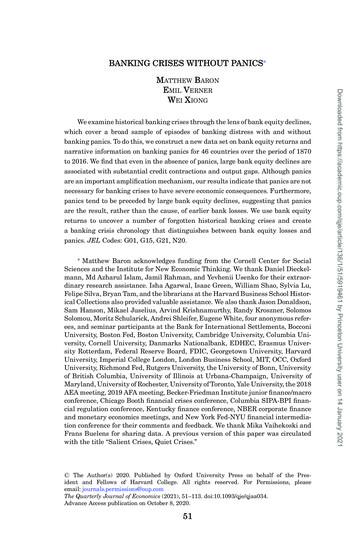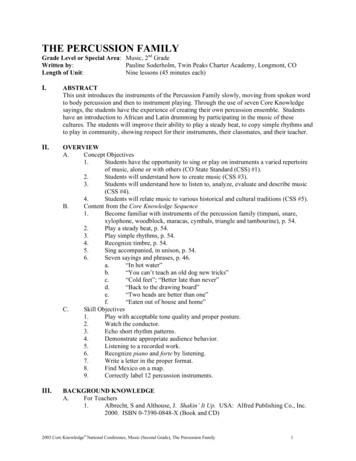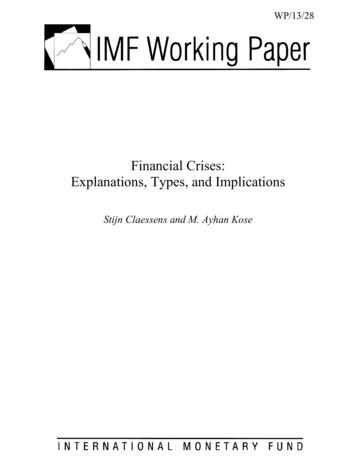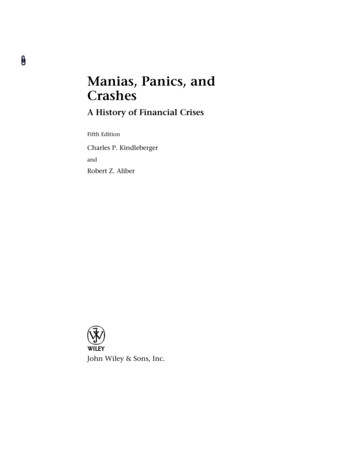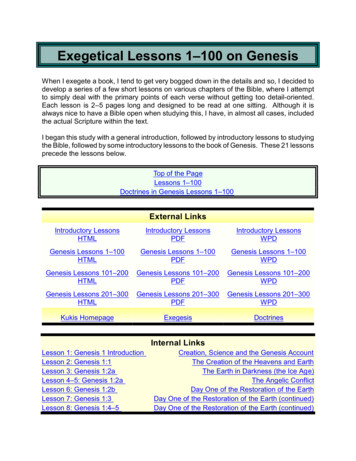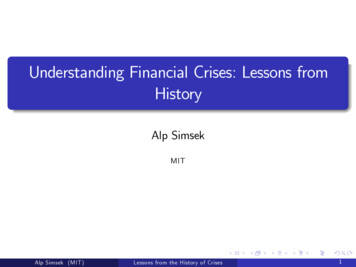
Transcription
Understanding Financial Crises: Lessons fromHistoryAlp SimsekMITAlp Simsek (MIT)Lessons from the History of Crises1
Roadmap1Course logistics2The subprime crisis of 2007-20093Some lessons from the history of crisesAlp Simsek (MIT)Lessons from the History of Crises2
Alp Simsek: IntroductionAssociate Professor of EconomicsRaised in TurkeyMIT undergraduate in mathematics and computer scienceMIT Ph.D. in economics, 2010Specialize in macroeconomics and financeAlp Simsek (MIT)Lessons from the History of Crises3
Why should you take this mini-course?We will take an academic look at financial-banking crises:How often do they happen?Why do we care? From Wall Street to Main Street?Why do they happen?How do they get out of control?What to do about them?General mechanisms. Subprime crisis as case study/empiricsAlp Simsek (MIT)Lessons from the History of Crises4
Course resources and requirementsReadingsNo textbook.Lectures: 8 lectures.Grading: Pass/FailParticipation: 30%Take-home exam: 70%Distributed at the end of the last lecture. Due in 24 hours.Alp Simsek (MIT)Lessons from the History of Crises5
Roadmap1Course logistics2The subprime crisis of 2007-20093Some lessons from the history of crisesAlp Simsek (MIT)Lessons from the History of Crises6
Financial system channels resources to usesAlp Simsek (MIT)Lessons from the History of Crises7
Mortgages: Loans collateralized by housesI&ippliers of capital . melXNsS3Virqs· RIms . C I!!hIUsers of capital·FiIms tINI1 .,.",. Go Ul II"ots IfIaI. SP8Ild. do:b W)'Ing a hou,.,Subprime mortgage: Borrowers with lower credit ratings.Alp Simsek (MIT)Lessons from the History of Crises8
Solution: Securitization redistributes mortgage risksAlp Simsek (MIT)Lessons from the History of Crises9
Aside: Derivatives and securitizationDerivative security: Value derives from another security.Financial innovation created new derivatives in recent years.An interesting example is collateralized debt obligations (CDOs).These are constructed in two steps:Pool underlying securities (mortgages, but also corporate bonds,loans etc).Sell claims to parts of the cash fiows on the pool (“tranches”).Alp Simsek (MIT)Lessons from the History of Crises10
Structure of a CDOConsider a bond with promise (or face value) of 100.Suppose (for simplicity) it pays 0 in case of default.Construct an equally weighted portfolio of many such bonds.Create tranches by seniority:The most senior tranche has a face value of 70. It pays in fullunless over 30% of the bonds default, in which case it pays theremaining value of the bonds.The next most senior has a face value of 15. It pays in fullunless over 15% of the bonds default, in which case it payswhatever remaining value is above 70.And so on until you reach the equity tranche, which has a facevalue of 3 and pays only the value of the bond portfolio above 97.Alp Simsek (MIT)Lessons from the History of Crises11
Structure of a CDOEquity TrancheMezzanine TrancheSenior TrancheSuper Senior Tranche708597 100Bond Portfolio’s Ability to PayImage by MIT OpenCourseWare.Alp Simsek (MIT)Lessons from the History of Crises12
Why CDOs?Credit rating agencies rate bonds according to probability ofpaying in full.There is a scarcity of the bonds with the highest rating (AAA):These bonds account for only about 5% of the supply ofcorporate bonds,But many institutional investors are restricted to hold onlyhigh-rated bonds.CDO creates a supply of AAA tranches even if no individualbond is rated AAA.The low-rated tranches can be sold to hedge funds and otherinvestors who are looking for high yield and can tolerate highrisk.Alp Simsek (MIT)Lessons from the History of Crises13
CDO alchemyCourtesy of Efraim Benmelech and Jennifer Dlugosz. Used with permission.Figure: From Benmelech and Dlugosz (2009).Alp Simsek (MIT)Lessons from the History of Crises14
Are CDO ratings reliable?Pitfalls with CDO ratings:1Unlike AAA bonds, AAA tranches of CDOs are “optimized”sothat there is just enough collateral to ensure AAA rating.Riskier than a AAA bond (marginally AAA).2In view of diversification, the risk of AAA tranchesdepends on the probability of a negative aggregateshock (recession, falling house prices etc.) that affectsmany underlying securities simultaneously.3Rating agencies are good at modeling idiosyncratic default risk.Not so good at modeling aggregate shocks (and correlations).Alp Simsek (MIT)Lessons from the History of Crises15
Back to story: Subprime mortgages securitizedSubprimeTotalSubprime Share in TotalMortgageOriginations OriginationsOriginations(% of(Billions)(Billions)Dollar rcentSubprimeSecuritized(% ofDollar Value)2001 2,215 1908.6% 9550.4%2002 2,885 2318.0% 12152.7%2003 3,945 3358.5% 20260.5%2004 2,920 54018.5% 40174.3%2005 3,120 62520.0% 50781.2%2006 2,980 60020.1% 48380.5%Image by MIT OpenCourseWare.This is vulnerable to a drop in nationwide house prices. Why?Alp Simsek (MIT)Lessons from the History of Crises16
House prices rose and then fell.Alp Simsek (MIT)Lessons from the History of Crises17
Defaults and delinquencies increasedPAST DUE MORTGAGES3025Percent20Sub-PrimePast Due1510Prime 1919980Image by MIT OpenCourseWare.Alp Simsek (MIT)Lessons from the History of Crises18
Markets recognized risks in AAA tranchesFigure: From Brunnermeier (2009).Courtesy of Markus K. Brunnermeier. Used with permission.The spreads are calculated from CDS prices. They provide ameasure of the default probability for corresponding tranches.Alp Simsek (MIT)Lessons from the History of Crises19
Aside on credit default swaps (CDS)A CDS is an insurance contract on the default of a particularbond.For example, suppose you own a corporate bond from companyXYZ with principal 1,000. If company XYZ defaults, you mightget back 500 instead of 1,000.You may buy a CDS for XYZ from someone (CDS seller). In thiscase, you will definitely get 1,000.If XYZ defaults, the CDS seller pays you 1000 (in exchange forthe bond) so that your total of 1000 is guaranteed.You “swap” the default risk with the CDS seller.Alp Simsek (MIT)Lessons from the History of Crises20
ExampleIn October 2008, the 5-year CDS rate on Morgan Stanley debtwith face value 10,000 was 1,000.This means that you could enter a swap where you paid 1,000a year for five years, and in return you get payment 10,000 ifMS defaults (in exchange for the MS bond).This price provides a measure of the probability that MS willdefault. For example, if the recovery rate on MS debt is 50% (ina default, MS would only pay fifty cents on the dollar), this(roughly) implies:20% chance that Morgan Stanley would default in the next year,About 70% chance of default in the next five years.Alp Simsek (MIT)Lessons from the History of Crises21
CDS during the Euro-debt crisis Cable News Network. All rights reserved. This content is excluded from our CreativeCommons license. For more information, see http://ocw.mit.edu/help/faq-fair-use/.Estimated probability of default on sovereign bonds over the next fiveyears in September 2011 (CNNMoney article on September 16).Alp Simsek (MIT)Lessons from the History of Crises22
Back to story: Markets recognized risksCourtesy of Markus K. Brunnermeier. Used with permission.Figure: From Brunnermeier (2009).Alp Simsek (MIT)Lessons from the History of Crises23
Key aspect: Some financial institutions made lossesKrishnamurthy (2010), “How Debt Markets Have Malfunctionedin the Crisis.”Courtesy of the American Economic Association. Used with permission.Alp Simsek (MIT)Lessons from the History of Crises24
Their default risks increasedCourtesy of Markus K. Brunnermeier. Used with permission.Figure: From Brunnermeier (2009).Alp Simsek (MIT)Lessons from the History of Crises25
Some of them became bankruptSome others (Bear Sterns, Freddie, Fannie, AIG.) were bailed outwith government support.Alp Simsek (MIT)Lessons from the History of Crises26
Stock market crashedAlp Simsek (MIT)Lessons from the History of Crises27
The US economy entered the Great RecessionUS Real Yearly 009200420052006200200220031120020002001Billions of Chained 2005 Dollars13700DateImage by MIT OpenCourseWare.Alp Simsek (MIT)Lessons from the History of Crises28
Economic activity fell below potentialCourtesy of the Congressional Budget Office. This work is in the public domain.Triggered strong policy response by the Fed and the treasury.Alp Simsek (MIT)Lessons from the History of Crises29
Monetary policy appears to be constrainedCourtesy of the Board of Governors of the Federal Reserve. This image is in the public domain.Triggered unconventional policies: Quantitative easing etc.Triggered also bailouts and stabilizers, which raised deficits.Alp Simsek (MIT)Lessons from the History of Crises30
Fiscal policy steps in, raising government deficitsCourtesy of the Congressional Budget Office. This work is in the public domain.Alp Simsek (MIT)Lessons from the History of Crises31
The shock seemed small relative to damage One feature of the subprime crisis is that the initiating shock seemed to besmall relative to the ultimate damage it caused. Blanchard (2009, “The Crisis: Basic Mechanisms and Appropriate Policies”)notes that:o The estimated losses in the U.S. subprime market in October 2007was around 250 billion dollarso The cumulative world output loss relative to trend between 2008and 2015 (based on IMF estimates) was around 4700 billiondollars. About 20 times the initial loss in the subprime market!o The cumulative loss in the world stock markets from July 2007 toNovember 2008 was about 26400 billion. About 100 times theinitial loss!Alp Simsek (MIT)Lessons from the History of Crises32
The mystery of the subprime crisis: Whodunit?The subprime crisis features many candidates for a culprit:123456Extension of subprime loans by banks, e.g., lax lending standards.Securitization and the CDOs.Rating agencies.CDS (looks innocent so far, but still a key character)Large financial institutions that made the losses.Government (Fed treasury) suport or bailout of banksIn fact, books written (movies made) about each candidate.But economics is about prioritizing & focusing on first order.Where should we focus our efforts? Some history could help.Alp Simsek (MIT)Lessons from the History of Crises33
Roadmap1Course logistics2The subprime crisis of 2007-20093Some lessons from the history of crisesAlp Simsek (MIT)Lessons from the History of Crises34
Lessons from history: Crises are “universal”Allen and Gale (2009): Crises are “universal”phenomena.They happened in different periods and in different countries.They happened in developing and developed countries.AG discuss Bordo et al. (2001), who analyze the incidence ofcrisesin 21 countries over 120 years.123Banking crises: Erosion of most banking capital.Currency crises: Forex attacks and devaluation (not our focus).Twin crises: Both at the same time.Alp Simsek (MIT)Lessons from the History of Crises35
Bordo et al. (2001) find that:Banking crises are relatively common in most timeperiods (except for 1945-1971---highly regulated)They also happen in developed countries--albeitless frequentlyTheir aftermath is typically associated with severeoutput losses.Schularick-Taylor (AER, 2012) analyze the relationshipbetween banking crises and output more systematically.Alp Simsek (MIT)Lessons from the History of Crises36
Schularick-Taylor (AER, 2012):They date 79 banking crises (denoted by year 0 in the figure) andanalyze the evolution of investment and output in their aftermath.Courtesy of Moritz Schularick and Alan M. Taylor. Used with permission.Severe drops in investment and output, partial recovery.Alp Simsek (MIT)Lessons from the History of Crises37
Cerra and Saxena (AER, 2008) do a similar analysis asSchularick-Taylor using an alternative data set that covers 190countries between 1960-2001.Courtesy of Valerie Cerra and Sweta Chaman Saxana. Used with permission.They find much more persistent effects, little recovery.Alp Simsek (MIT)Lessons from the History of Crises38
Lessons from history: Optimism/bad news Cerra-Saxena also find optimism during the crisis. Growthforecasts systematically revised downwards as crisis unfolds. In their popular book, "This Time is Different," Reinhart andRogoff also emphasize optimism before and during crises. As we will see, optimism was also arguably widespread beforeand during the subprime crisis.Alp Simsek (MIT)Lessons from the History of Crises39
Examples from recent historyRead Allen and Gale (2009) for a brief discussion of recent crises:Scandinavian crises (Norway, Finland, Sweden) of early 1990s.The Japanese crisis of early 1990sAsian crises of late 1990s (Asian “dragons” & “tigers”):Russian default of 1998 and the LTCM mini-crisis in the US.The Argentina crisis of early 2000s.Alp Simsek (MIT)Lessons from the History of Crises40
Lessons from history: SummaryHistory suggests:1Bankingcrises are common. Can happen in developed economies.The following features are also quite common in crises:2. Crises are typically followed by large drops in output.3. Crises are associated with ex-ante optimism/ex-post badnews.Alp Simsek (MIT)Lessons from the History of Crises41
Back to the subprime crisis: Whodunit?Recall that we had the following candidates for blame:123456Extension of subprime loans by banks, e.g., lax lending standards.Securitization and the CDOs.Rating agencies.CDS (looks innocent so far, but still a key character)Large financial institutions that made the losses.Government support of bailout of banksAlp Simsek (MIT)Lessons from the History of Crises42
Common denominator: Banks and the governmentUniversality suggests points 1-4 might not be so central:Banking crises happened without subprime, CDOs, ratingagencies, CDS.In contrast, point 5 appears to be a common feature of crises.Severe financial events that don’t involve banks need notgenerate crises. The bust of the NASDAQ bubble in 2001 wipedout a lot of wealth (more than subprime). But banks were notexposed. Only mild recession.Point 6 is also in the mix. Most episodes feature gov support.Alp Simsek (MIT)Lessons from the History of Crises43
Roadmap for the rest of the courseWe made a tiny bit of progress, but several issues remain:Transmission: How do banks’problems affect the economy?Amplification: How do “small” shocks generate large damage?Causes: What are the ultimate causes of bank losses?Panics: Why are crises often associated with a panic?What is the role of optimism/bad news in losses or panics?Solutions: Optimal policy during a crisis? How about before?Alp Simsek (MIT)Lessons from the History of Crises44
Roadmap for the rest of the courseLecture 2: Borrowing constraints and the net worth channelLecture 3: Leverage, fire sales, and amplification mechanismsLecture 4: Understanding banks’losses: Moral hazard ormistakesLecture 5: Liquidity, part 1: Maturity mismatch and bankingpanicsLecture 6: Liquidity, part 2: Debt, information-based panics, andfiight to qualityLecture 7: Interconnections and complexity.Lecture 8: Optimal policy: How to mitigate or prevent crises?For review, read the chapter by Allen and Gale (2009).For tomorrow, read the intro of Holmstrom and Tirole (1997).Alp Simsek (MIT)Lessons from the History of Crises45
MIT OpenCourseWarehttp://ocw.mit.edu14.09 Financial CrisesJanuary IAP 2016For information about citing these materials or our Terms of Use, visit: http://ocw.mit.edu/terms.48
Lessons from history: Crises are "universal" Allen and Gale (2009): Crises are "universal"phenomena. They happened in different periods and in different countries.


